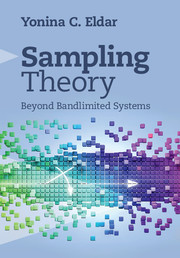Book contents
- Frontmatter
- Dedication
- Contents
- Preface
- 1 Introduction
- 2 Introduction to linear algebra
- 3 Fourier analysis
- 4 Signal spaces
- 5 Shift-invariant spaces
- 6 Subspace priors
- 7 Smoothness priors
- 8 Nonlinear sampling
- 9 Resampling
- 10 Union of subspaces
- 11 Compressed sensing
- 12 Sampling over finite unions
- 13 Sampling over shift-invariant unions
- 14 Multiband sampling
- 15 Finite rate of innovation sampling
- Appendix A Finite linear algebra
- Appendix B Stochastic signals
- References
- Index
12 - Sampling over finite unions
Published online by Cambridge University Press: 05 August 2014
- Frontmatter
- Dedication
- Contents
- Preface
- 1 Introduction
- 2 Introduction to linear algebra
- 3 Fourier analysis
- 4 Signal spaces
- 5 Shift-invariant spaces
- 6 Subspace priors
- 7 Smoothness priors
- 8 Nonlinear sampling
- 9 Resampling
- 10 Union of subspaces
- 11 Compressed sensing
- 12 Sampling over finite unions
- 13 Sampling over shift-invariant unions
- 14 Multiband sampling
- 15 Finite rate of innovation sampling
- Appendix A Finite linear algebra
- Appendix B Stochastic signals
- References
- Index
Summary
In the previous chapter we considered sampling of sparse finite-dimensional vectors. As we have seen, this setting can be viewed as a special case of a union model, where the subspaces Ui comprising the union are a direct sum of k one-dimensional subspaces, spanned by columns of the identity matrix. Thus, for each Ui = U, we have that
where ∈j, 1 ≤ j ≤ N is the subspace spanned by the jth column of the N × N identity matrix, and ij, 1 ≤ j ≤ k are indices between 1 and N.
Viewing the sparsity model in the form of a UoS such as (12.1) leads to an immediate extension which allows formuchmore general signal classes. Specifically, we may replace each of the one-dimensional subspaces ∈j of ℝN by a subspace Aj. These subspaces have arbitrary dimension, and are described over an arbitrary Hilbert space H. In particular, they can represent subspaces of analog signals. In this chapter we focus on finite- dimensional unions of this form, on methods for recovering signals that lie in the union from few measurements, and on performance guarantees. We also consider learning the subspaces from training data, when the possible subspaces are not known in advance. Finally, we treat the more difficult scenario of subspace learning from compressed data, leading to an extension of compressed sensing referred to as blind compressed sensing.
- Type
- Chapter
- Information
- Sampling TheoryBeyond Bandlimited Systems, pp. 472 - 533Publisher: Cambridge University PressPrint publication year: 2015



